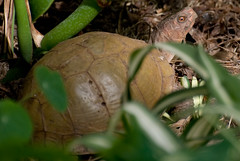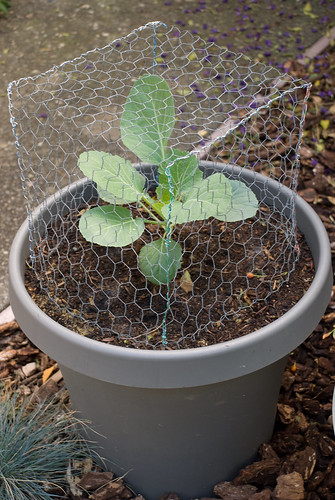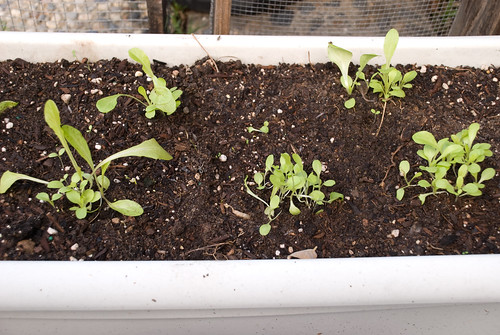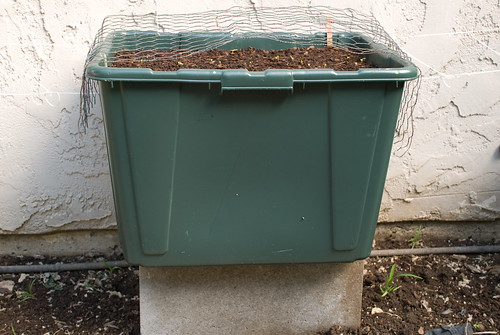I also talked about the winding down of my Summer garden and promised that I'd talk about my Winter garden in my next post. As promised...
Ready for Winter
As I mentioned in a couple of earlier posts, I decided to work at putting in a winter veggie garden. I have pretty much finished starting seeds in 6-packs, transplanting seedlings, and direct-seeding my winter veggies just in time for our Wet season.
I bought a 6-pack of cabbage seedlings a few weeks ago. I gave some away, transplanted two into a pair of really big plastic pots (one per pot so they'll have plenty of room to grow).
The poor thing is caged because the neighborhood cats like nothing better than to use these pots as their litter box and the squirrels tend to cause damage to my plants in favor of planting their nuts. I have potted up the other two seedlings I kept to 1-gallon pots to give me a little time to find two more roomy places to plant them. (In the ground they need 18 inches between centers.)
About a month ago I seeded two varieties of heirloom lettuce (head and leaf) in 6-packs. This weekend I transplanted them into rectangular plastic planting tubs that I reclaimed from lackluster "traditional" plantings (gladiolus in the one and bearded iris in the other). Already they have settled in and are growing stronger by the day.
As you can see, the plugs from the 6-packs are chock-full of loose-leaf lettuce seedlings. Oddly enough, I had thinned each and every cell down to a couple of seedlings each several days before transplanting. All of those little seedlings have sprouted since they were transplanted! Yes, I need to re-thin all those seedlings.
Over a month ago I seeded Super Sugar Snap peas in 6-packs. Their germination rate was disheartening, only about 25%. Still, that gave me a half-dozen seedlings to transplant. When I removed the cucumbers I discovered that the soil in that bed is heavily infested with root knot nematodes. (I'll be doing a separate post about this a little later.) So, the planting bed where I had planned to plant the peas is basically unusable for now. I had to come up with an alternative.
My alternative is a little... ummm... creative. In my neighborhood, we now recycle using a ginormous, wheeled toter into which *all* recyclables are placed. We used to use three bins, one each for glass, cans, and newspaper. We had a choice of turning in the bins to be recycled or keep them for reuse. Well, I had kept mine. Specifically, I had kept mine to use as planting tubs... someday. Well, this is now "someday."
I spray painted the bright-yellow bins (with black illustrations on how to recycle in three languages) "Hunt Club Green" and filled them with a mixture of "Planting Mix" and "Garden Compost." I put the painted, filled bins on top of cinder blocks on top of the infested soil. I transplanted the pea seedlings into the first bin and direct-seeded more peas into the second bin. I will direct-seed another set of peas into the third bin this weekend.
Also in the recycled recycle bins, I planted two rows of bok choi in each bin. Amazingly enough, the rows of bok choi are jumping up out of the soil at an alarming rate. That's another set of seedlings that I need to thin very soon.
Meanwhile, I have direct-seeded some Bloomsdale Longstanding spinach into a pot, some Baby Leaf Catalina spinach into another pot, and Jewel-Toned Beets (Red, Gold, & Candystripe) into yet another pot. (These beets are intended to be grown for their roots, but I'll probably also harvest some greens.) The beets have already started sprouting and I have already started thinning them. The spinach are still in stealth mode.
In addition to the above, I'm also growing some herbs. I transplanted some dill and chives into a pot a few weeks ago. The chives seemed to be thriving, but the dill was not. It was looking a little more sad each week. Well, I got in there with my reading glasses today and discovered that it was infested with two kinds of aphids. I have now sprayed them with some soapy water. That should do it, but I'll have to keep an eye on them AND the rest of the veggies in the area to make sure they didn't travel.
I also transplanted some Sweet Basil that I had started in a 6-pack into a window box-like planter. Hopefully I can get some harvested before they are nipped by cold.
So, there you have the starts of my winter garden. There's still plenty of summer garden left giving me fresh vegetables. The winter garden is off to a grand start. There's still more to do (like planting the third recycle bin and thinning seedlings), but I like how it's going so far.
So, there you have the starts of my winter garden. There's still plenty of summer garden left giving me fresh vegetables. The winter garden is off to a grand start. There's still more to do (like planting the third recycle bin and thinning seedlings), but I like how it's going so far.













That's a pretty spiffy wire cage. You make those yourself?
ReplyDeleteMaster Composters use the old recycling bins as worm bins. We drill holes, add feet and a lid, and voila! Worm bins with instructions for recycling on the sides!
I really like that wire cage, too. Actually, three! They were made by (ready?) Mom's former tenant's father. He also made all those wooden flats with the matching wood-framed, hardware cloth-covered lids. Handy guy!
ReplyDeleteHe has inspired me, so I have procured some poultry wire and some fine gauge wire to stitch the seams. I need something bigger and rounder for the cabbage pots and other semi-custom applications.
Good for the Master Composters! I'm all about the recycle, reuse, renew thing and have been for... OMG! *that* many years?!?! I just had a hard time with the idea of having bright-yellow-with-recycling-instructions bins along the walkway to my front door. "Hunt Club Green" seems a little more attractive, even if it is for front yard vegetable gardening.